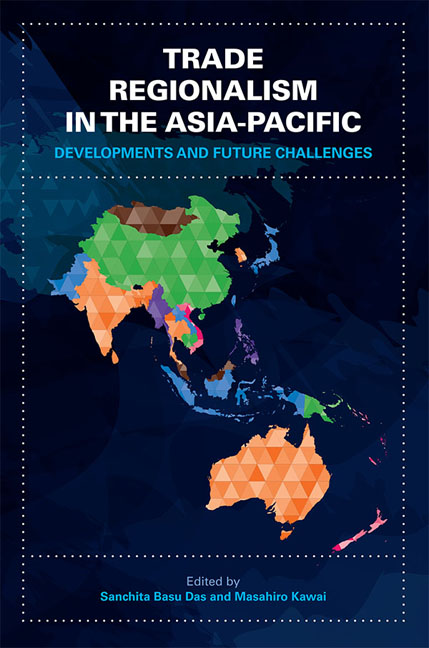Book contents
- Frontmatter
- Contents
- Foreword
- Acknowledgments
- List of Abbreviations
- The Contributors
- 1 Introductory Overview — Trade Regionalism in the Asia-Pacific: Developments and Future Challenges
- I The Trans-Pacific Partnership (TPP) Agreement
- II The Regional Comprehensive Economic Partnership (RCEP) Agreement
- III Regional Economic Integration: A Multi-stage Approach
- IV Old and Emerging Approaches to Asia-Pacific Regional Integration
- 12 APEC at 25: Political Realities Realized
- 13 The TTIP, Mega-regionalism and Asia
- 14 The Pacific Alliance: A Bridge between Latin America and the Asia-Pacific?
- V Asia-Pacific Regional Integration: Towards Convergence?
- Index
13 - The TTIP, Mega-regionalism and Asia
from IV - Old and Emerging Approaches to Asia-Pacific Regional Integration
Published online by Cambridge University Press: 05 July 2016
- Frontmatter
- Contents
- Foreword
- Acknowledgments
- List of Abbreviations
- The Contributors
- 1 Introductory Overview — Trade Regionalism in the Asia-Pacific: Developments and Future Challenges
- I The Trans-Pacific Partnership (TPP) Agreement
- II The Regional Comprehensive Economic Partnership (RCEP) Agreement
- III Regional Economic Integration: A Multi-stage Approach
- IV Old and Emerging Approaches to Asia-Pacific Regional Integration
- 12 APEC at 25: Political Realities Realized
- 13 The TTIP, Mega-regionalism and Asia
- 14 The Pacific Alliance: A Bridge between Latin America and the Asia-Pacific?
- V Asia-Pacific Regional Integration: Towards Convergence?
- Index
Summary
INTRODUCTION
The United States and the European Union (EU) launched negotiations for a possible Transatlantic Trade and Investment Partnership (TTIP) in July 2013. The goal of the TTIP is to create a modern, comprehensive free-trade area that would unite the two largest economic areas in the world. Thus far, the TTIP has undergone eleven negotiating rounds, the seventh having been held from 19–23 October 2015. As the United States and the EU are among the most open economies in the world, the negotiations are focusing on what might be characterized as “high-hanging” fruit, that is, politically difficult issues such as sensitive agricultural products, the financial sector, product standards, sanitary and phytosanitary (SPS — included issues related to animal welfare), the protection of intellectual property rights (IPR), and government procurement. Coupled with the usual political baggage associated with transatlantic relations and election-year politics in the United States, the scope and depth of the arrangement has generated extensive debates particularly in Europe. When the TTIP was launched, United States Trade Representative (USTR) Michael Froman expressed hope that it would be completed “on one tank of gas”. The long and winding road of trade negotiations has already required quite a bit of refuelling. Will it reach its destination?
There are reasons to be optimistic about the accord. The United States and European countries have been key leaders in post-World War II economic governance and in promoting liberalization of global trade and investment. They have been active in the General Agreement on Tariffs and Trade (GATT) and World Trade Organization (WTO) in trying to bring down tariffs and non-tariff barriers (NTBs) globally, and their respective political and economic institutions related to trade are among the most advanced in the world. There is good reason to believe that the ultimate benefits of the accord could be relatively large, despite the fact that their economies are already relatively open. Moreover, rapid growth in Asia and the “mega-regionalism” in the Asia-Pacific region, particularly the recently concluded Trans-Pacific Partnership (TPP), have created strong incentives for the EU to avoid being isolated from Asia- Pacific markets and regional rule-making that may well emerge as global rules.
- Type
- Chapter
- Information
- Trade Regionalism in the Asia-PacificDevelopments and Future Challenges, pp. 256 - 272Publisher: ISEAS–Yusof Ishak InstitutePrint publication year: 2016

